

It may also change colour, change shape or feel numb. The ulnar column ( TFCC + Distal ulna): Stabilizes the DRUJ and forearm rotation.Ĭopyright © 2023, StatPearls Publishing LLC. You may have broken your arm or wrist if you've injured it and it suddenly became: painful. The intermediate column (Lunate fossa): is responsible for load transmission from the carpus to the forearm. It acts as a load-bearing strut for wrist ulnar deviation. It works as a buttress for radial translation of the carpus and holds it to length radially for even load distribution across the scaphoid and lunate fossae. It has the attachment of the brachioradialis tendon, long radiolunate ligament, and radioscaphocapitate ligament, which prevents ulnar translation of the carpus. T he radial column ( radial styloid + scaphoid fossa): The distal radius has three columns radial, intermediate and ulnar columns. It has the following articulations scaphoid ( scaphoid fossa), lunate ( lunate fossa), and distal ulna ( ulnar or sigmoid notch). The distal radius bears 80% of the axial load.

It occurs when a person falls forwards and plants their outstretched hand in front of them. This type of fracture typically occurs as a fragility fracture in osteoporotic bone. These distal radius fractures are often caused by falling on an outstretched hand with the wrist in dorsiflexion, causing tension on the volar aspect of the wrist, causing the fracture to extend dorsally. A Colles’ fracture describes an extra-articular fracture of the distal radius with dorsal angulation and dorsal displacement, within 2cm of the articular surface.

A Broken Wrist or Colles Fracture is most common in women over 50 years of. The term Colles fracture is often used eponymously for distal fractures with dorsal angulation. Colles Fracture or a Broken wrist is the most common fracture of the arm or wrist. The Colles fracture is defined as a distal radius fracture with dorsal comminution, dorsal angulation, dorsal displacement, radial shortening, and an associated ulnar styloid fracture. Named after Abraham Colles, who first described a distal radius fracture in 1814 at the Royal College of Surgeons in Dublin, the Colles fracture is one of the most common fractures encountered in orthopedic practice representing 17.5 % (one-sixth) of all adult fractures presenting to the emergency department.


 0 kommentar(er)
0 kommentar(er)
